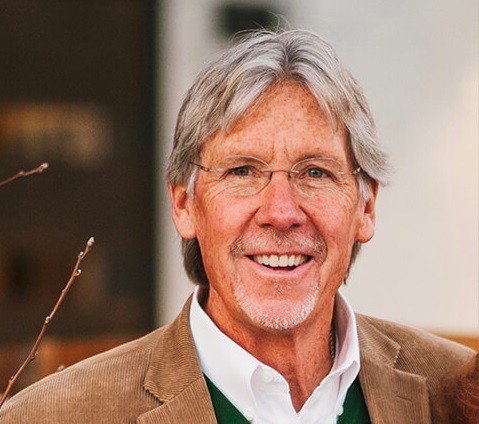 RamNation Radio hosted former CSU athletic director Jack Graham and his wife Ginger on a podcast episode this week. Both were tremendously engaging and thoughtful in talking about a variety of topics. Below we share some of Jack’s most notable comments from the conversation. Of course, this is only a fraction of the topics discussed and we’ve only included segments of his full comments, so we encourage you to give the full episode a listen!
RamNation Radio hosted former CSU athletic director Jack Graham and his wife Ginger on a podcast episode this week. Both were tremendously engaging and thoughtful in talking about a variety of topics. Below we share some of Jack’s most notable comments from the conversation. Of course, this is only a fraction of the topics discussed and we’ve only included segments of his full comments, so we encourage you to give the full episode a listen!
Listen to “Former CSU A.D. Jack Graham and wife Ginger talk CSU and much more!” on Spreaker.
On the new huge geographic footprints in conferences impacting student athletes
“When I traveled to Hawaii when CSU played Hawaii…which is a comparable distance to the East Coast…it turned the student athletes’ life inside out for about three days. So, I don’t think the student athletes’ well being is what’s driving this process and it absolutely should be front and center.”
On realignment scenarios in 2011-12 and what was happening with the Mountain West
“We had talked about forming our own conference that was going to pick off schools from some of the other mid-major conferences. We were thinking about schools like Cincinnati, Houston, SMU, and schools of that ilk, in combination with the stronger schools from the Mountain West Conference. The geography of that whole conversation was always front and center because you’re always trying to recruit schools that have got strong population centers because of the value of media rights in those centers.”
On how CSU will end up after this latest round of realignment
“I think the future of CSU is not doomed by any stretch of the imagination because of all of this conference realignment that’s taking place. Are we going to be invited to join a Power 5 conference? I seriously doubt it. I just don’t see that being in the cards. The Big 12 is off the table in my opinion. But I do see the constitution of a strengthened Mountain West in combination with some of the Pac-12 teams. I could see a conference that would include the Mountain Schools – New Mexico, Air Force, CSU, Wyoming, UNLV. Maybe Nevada, I’m not sure I’d include Nevada. Utah State – I love Utah State and their standards and how hard they compete. I think Utah State does some great things, but it’s such a remote market I don’t see much value. But, take the core Mountain schools in combination with a couple schools from Texas – SMU, Rice, (UTSA). And then of course the Pac-12 schools…
“Then of course you also have San Diego State, Fresno State, and San Jose State. You’d throw Hawaii out of the conference. Hawaii is an incredibly expensive place to go play football, and as I said it’s really tough on the student athletes to travel that distance. So, I think you could clean some things up and create a very, very strong conference. And if you could maintain the Pac-12 name through that process, an outside chance – not a strong chance – but an outside chance that that new conference configuration would remain a Power 5 conference. Don’t think it would happen, but there’s always an outside chance.”
On the Rams’ struggles in football keeping CSU out of Power conference consideration
“I think three years ago, there’s a chance that could have occured (CSU being picked up in power conference expansion, if it was relevant in football). I think (Jim McElwain) clearly had the capability and the track record of running a very successful program. And I think he would have had us as a top-25 school year in and year out. I’ve always said there were three things we’ve got to do: We’ve got to win in football, we’ve got to win in football, we’ve got to win in football. That’s essential to a successful athletic department. It’s the engine that drives everything. But in addition to winning, you’ve got to get people to turn their TV sets on in Denver, in the Denver Metro Area, and prove to the media rights people that you’re bringing value to the conversation if you’re going to be brought into a power conference. And you’ve got to fill the stadium as well.”
On being fired by CSU and why he was fired
“I’m still pissed off, are you kidding me? I loved that job. It was the best job I ever had. I loved the student athletes. I loved the coaches and the fans. I was a private sector guy. I was raised in business and coached up in business. And kind of like what you got to do to succeed in an athletic department is win football games, win football games, win football games, you’ve gotta deliver results, deliver results, deliver results, and you’re fully accountable for that. And if you bring that kind of a culture into a publicly adminstered state university, it’s a culture shock. I can see all kinds of mistakes I made in terms of relationships and things of that sort. So I take accountability for all those things. But at the same time, that was the transformation that needed to take place, and I don’t think I would have changed a thing.”
“Tony (Frank) and I had a great working relationship. I had, and still have, an enormous amount of respect for him. I think that the speed of the changes I was bringing to the athletic department, which whether you like it or not, as goes the athletic department, so goes the rest of the university – so we were under the microscope, and it was terrifying a lot of bureaucratic administrators inside the administration. So, that was the rift that was taking place.”
“I had a couple of employees lie to me. Stunning, in my opinion, that anybody would lie to someone else in business. But I had a couple employees lie to me, and it was impossible to fire them. That’s the difference between a public environment and a private sector environment. It’s very inefficient. It doesn’t work well. It doesn’t work as well as it could.”
On his donation to the Indoor Practice Facility and how it led to him becoming AD
“Paul Kowalczyk was the athletic director at the time. And first of all, I saw the indoor practice facility for the first time after it was built. And it was 60 yards long. And I had a hissy fit. I said ‘Where in the hell are the other 60 yards? Football fields are 120 yards long – 10 yards on each endzone and 100 yards. So, it was again a reflection of what I call the ‘standards of mediocrity’ that have prevailed for so long and so many times at CSU that just drives all of us crazy. And so I was kind of pounding my fist with Paul about that. And I said, ‘And besides that, Paul, we’ve gotta move the stadium on campus or we’re never going to have any traditions here. I think it’s critical if we’re ever going to recover this thing’. So, he said ‘Why don’t you go talk to the president,’ and I said ‘Sure, I’ll go talk to the president.’”
“And so that’s how Tony (Frank) and I became familiar with each other. I talked to him at length about (the stadium vision). He bought into the vision. He saw it. I think he agreed with it, and I think he was right to agree with it. It does have a transformative power. We’ll get there. It’s taken longer than any of us wanted, but we’ll get there.”
On forcing the high standards for the on-campus stadium project
“So much frustration in forcing everyone to maintain very, very high standards of what the design of the stadium should be. There was just kind of this attitude that started to slip into the project that ‘let’s just get a stadium on campus, that’s good enough’. A lot of friction came out of that process. One of the things I did that was really helpful is I said we’re going to design the last 10% of this stadium first. What’s the branding going to look like, what’s the scoreboard going to look like. Because by the time you get done building the stadium, nobody’s ever got money for the last 10% and you don’t get to tie a yellow ribbon around it and that really compromises it. I think they did a great job of branding the stadium and putting a yellow ribbon around it. I think it looks terrific.”
On battling with the Save Our Stadium Hughes people during the on-campus stadium project
“Whether it’s a private sector project or even a university project, the community is going to have a voice. Sometimes the voice is rational and other times it’s irrational. In this instance, I thought it was really irrational. But, you have to take your patience pill. And you just have to answer the questions and move on. And, I’ve had so many of the SOS Hughes people who were vehemently opposed to the stadium and downright nasty at times come up to me after the stadium was completed and say, ‘You were right. We were wrong. This is terrific. It’s the right thing, and we’re so glad it happened.’ I’ve had many people approach me and say that to me.”
On still being connected to the CSU athletic department despite being fired
“It’s fun to be an alumni. It’s fun to see your university succeed. I still want that for CSU and I’ll still do my part to make that happen.”
On Larry Eustachy, who he hired, but later wanted to fire
“I will tell you that Larry was my big mistake. He was a big mistake. I didn’t like the way he treated his staff, in particular. And I didn’t like the way he treated his players. I don’t think there was any physical abuse. But I just felt it wasn’t the right way to orient yourself towards your staff and towards the players. If I could have made a change on my own, I absolutely would have made that change a lot sooner than it happened.”
On NIL collectives
“What I don’t like, and I will never accept as a good thing, are the collectives. The collectives are wrong. One thing the NCAA has said is that there will be no ‘pay for play’. You can’t just give a kid money to play football. They actually have to do work to earn the NIL money that they’re being paid. And, of course, the NCAA is not enforcing that rule in any way, shape, or form. The University of Florida has $16 million in their collective. A third-string offensive tackle is making $75,000 a year. Tell me he’s got any value in his name, image, or likeness. That is just abject pay for play. And it’s wrong. It’s perverted. If a kid has value and his name, image, and likeness has value, let him go out and market his name, image, and likeness. They can hire Learfield Sports to go do that for them. They can get their own agent to go do that for them. And capitalize on their own NIL. I think that’s terrific and it would be a great business experience for them.”
“But the collectives, including the collective that we’ve got at CSU, should all be shot. No university, no athletic program should be permitted to raise money to pay players for the value of their name, image, and likeness, full stop. Because that is pay for play. If that stopped, I think we would see individual players who’ve got big names make a lot of money. But you’re not going to see this broad distribution — it’s a multi-billion-dollar industry already. I think we’d see that come to an end, and I would love to see that happen.”
On being heavily involved with the Green and Gold Guard collective despite being vehemently opposed to NIL collectives
“Because I talk out of both sides of my mouth. I want to win! You know what? You can stand outside of the circle and bitch and moan and complain all you want. But that’s not going to help you win football games. So, let’s win football games and influence and try to change things at the same time. But I’m not going to be naïve about it.”
What were your favorite Jack Graham comments? Share on the RamNation message board!




